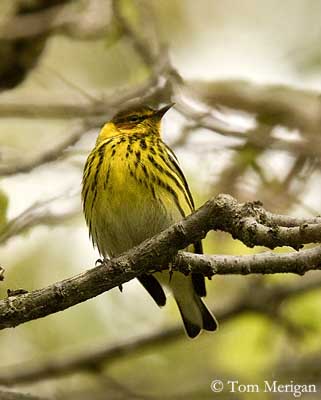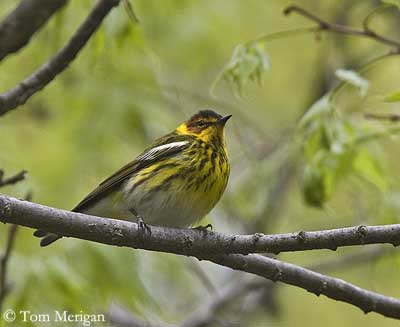
Fr: Paruline tigrée
All : Tigerwaldsänger
Esp: Chipe Tigre
Ital: Dendroica di Capo May
Nd: Tijgerzanger
Russe: Тигровый лесной певун
Sd: Brunkindad skogssångare
Photographers:
Photographes:
Tom Merigan
Tom Merigan’s Photo Galleries
Bob Moul
Nature Photography
Texte de Nicole Bouglouan
Sources:
A GUIDE TO THE BIRDS OF MEXICO AND NORTHERN CENTRAL AMERICA by Steve N. G. Howell, Sophie Webb - Oxford University Press - ISBN: 0198540124
FIELD GUIDE TO THE BIRDS OF NORTH AMERICA - National Geographic Society - ISBN: 0792274512
THE HANDBOOK OF BIRD IDENTIFICATION FOR EUROPE AND THE WESTERN PALEARCTIC by Mark Beaman, Steve Madge - C.Helm - ISBN: 0713639601
All About Birds (Cornell Lab of Ornithology)
Birds of Nova Scotia (Robie Tufts)
South Dakota Birds and Birding (Terry L. Sohl)
SORA Searchable Ornithological Research Archive (Blair O. Wolf)
What Bird-The ultimate Bird Guide (Mitchell Waite)
Wikipedia (Wikipedia, The Free Encyclopedia)
Cape May Warbler
Setophaga tigrina
Passeriforme Order – Parulidae Family
BIOMETRICS:
Length: 12-13 cm
Wingspan: 19-22 cm
Weight: 9-12 g
DESCRIPTION:
Cape May Warbler summer male is a distinctive brightly coloured warbler, with chestnut ear-coverts, blackish crown, very large white wing patch and bright yellow neck sides. This bird shows a combination of greenish upperparts and yellow underparts and sides of neck, and heavy streaking on underparts. It has an unstreaked yellow or yellowish rump, whitish wing bars and tail patches, dark legs and sharply pointed, slightly down-curved bill.

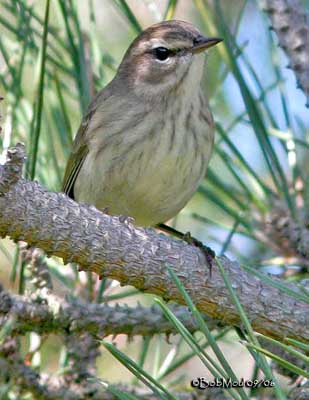
Female is duller, and lacks chestnut face or white wings patches.
In alternate plumage, male has yellow breast with thin black stripes, reddish and yellow face, pale sides of neck, and darker face, wing bars and yellowish rump.
Female is duller and has less olive with streaking less distinct.
Immature is similar to adult. Immature female may be dull grey overall, with only a hint of yellow on rump.
VOICE:
Cape May Warbler’s call is a thin, very high “tsip”. Song is a very high, sibilant “seet-seet-seet-seet”, a high pitched note repeated four to eight times. It usually sings from high perches.
HABITAT:
Cape May Warbler breeds in coniferous and mixed woodlands, especially spruce forests. At other times, it lives in all kinds of woodlands and thickets, but often favours pines.
RANGE:
Cape May Warbler breeds across the Canadian boreal forest, from Alberta to the Atlantic coast, and southward, to northern United States. It winters throughout the northern Caribbean, and on the Caribbean coast of Central America.
BEHAVIOUR:
Cape May Warbler picks insects from vegetation while perched, but also hawks insects. But this bird has a unique tongue among warblers, curled and semi tubular, allowing the bird to collect nectar in winter, through capillary action.
It lands on a branch, snatches insect, then glances around and flies off to another branch. It is very active. It will dart in the air and search among the needles of pines for food. It also consumes the juices of grapes, by poking a hole in the grape with the bill.
Cape May warbler has strikingly narrow bill easy to insert into flower corollas, or puncturing the sides of flowers to rob the nectar. They will also drink sap from sapsucker drill holes.
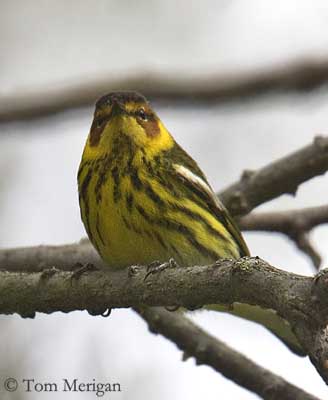
It is territorial, chasing away other warblers being on the same tree, singing its high song. It may pursue them through long distance, every 10 minutes or so.
Cape May warbler is a migratory bird, following the elliptical migration route, passing through certain areas only once a year. During migration, these birds show a curious attraction to ornamental spruces.
Cape May warbler is so named because it was collected at that world famous New Jersey migration site in 1811, by Alexander Wilson. But it seems not to have been recorded there again until September 1920.
FLIGHT:
Cape May warbler has an agile flight, and catches insects on the wing.
REPRODUCTION:
Cape May warbler’s nest is located on a branch of a spruce or fir, from 9 to 18 metres above the ground. It is made with grasses, twigs and mosses, and lined with hair and feathers. Nest is a small but bulky open cup.
Female lays 5 to 8 white eggs, with brown and grey spots, and incubates them. Time of incubation and fledging are unknown. This species lays large clutches in years when spruce budworm is abundant.
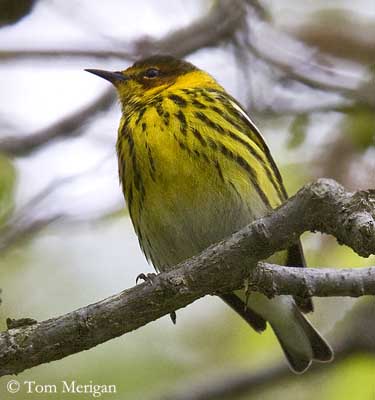
DIET:
Cape May warbler feeds mostly on insects such as caterpillars, spruce budworms, ants, flies, small bees, spiders and crickets. It also consumes plant nectar thanks to its unique tongue.
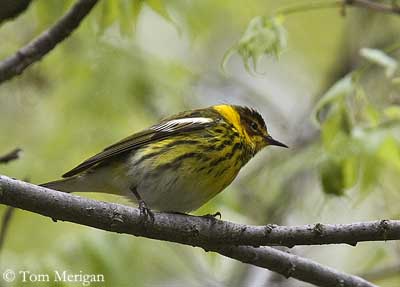
PROTECTION / THREATS / STATUS:
The use of insecticides to control spruce budworms populations causes decline in Cape May warbler numbers.
The reduced availability of the mature forests is another problem for this species.
However, the species is not threatened at this moment.
